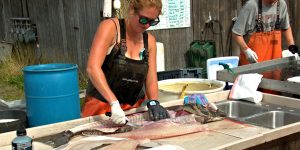How Much Does a Commercial Fisher Make in 2022?
 How much does a commercial fisher make? Thanks to popular shows like Alaska Fish Wars, Deadliest Catch, and Wicked Tuna, interest in the fishing industry is at an all-time high. But how much can a commercial fisher really expect to earn? This is the million-dollar question, and the short answer is, it depends. The long answer? It depends.
How much does a commercial fisher make? Thanks to popular shows like Alaska Fish Wars, Deadliest Catch, and Wicked Tuna, interest in the fishing industry is at an all-time high. But how much can a commercial fisher really expect to earn? This is the million-dollar question, and the short answer is, it depends. The long answer? It depends.
It depends on how long a worker is at sea. It depends on the location. It depends on the species being fished. It depends on how experienced the worker is, and it depends on the type of contract the fisher signs. In addition, the fishing industry is dependent on many factors that are beyond the worker’s control. The rewards can be tremendous. However, the hardships can be significant. Salaries vary widely between regions and are closely tied to seasonal conditions and experience. A good season can bring great rewards, while a poor season may have workers questioning their decision to work at sea. It is also one of the most dangerous jobs in the world.
According to ZipRecruiter (a job posting service and employment search engine), the average annual pay for a Commercial Fishers in the United States is $53,875. Annual salaries are reported as high as $79,000 and as low as $18,500, but most Commercial Fishing salaries are currently $40,500 (25th percentile) to $67,000 (75th percentile) per year across the United States.
Fishers are also often paid a percentage of the boat’s overall catch, commonly referred to as a “crew share”. The more fish that are caught, the greater the crew share becomes. This can lead to unpredictable swings in pay from one season to another, as the overall catch can vary wildly. It is usual for more experienced crewmembers to receive a greater share compared to entry-level workers.In another report prepared by the Bureau of Labor Statistics, employment in the fishing and hunting industry is expected to grow about 11 percent between 2016 and 2026. This is in part due to greater demand for seafood. As Americans become more health conscious, wild seafood is seen as a reliable source of nutritious protein.
According to the Alaska Fishing Employment Center, salmon fishermen can earn up to $20,000 in three months, while crab fishermen can make up to $15,000 per month. In past years, deckhands on Bering Sea crab-fishing vessels have been known to earn up to $100,000 over a six-month snow crab season.
It is also important to remember that fishing jobs are seasonal. For example, the first Copper River District opener on May 16, 2022, delivered 15,609 fish, including 12,737 sockeyes, 2,830 Chinooks and 42 chum. The second opener on May 19 delivered 14,724 fish, including 11,698 sockeyes, 2,670 Chinooks, and 354 chum.
There is also an enormous difference in job types. Seafood processing and cannery jobs are quite different than fishing jobs. However, for people new to the fishing industry, these processing jobs are a great first step and a way for students, seasonal workers, or those wishing to break into the industry to get started. Many processors including North Star Fishing Co. have openings right now that involve 65 and 90 day contracts. Of note, these positions are for 16 hour days, 7 days per week in all weather conditions. Pay is listed as $4,750 to $6,600 per month, which includes room and board.
Before signing on, talk with prospective employers and people who have worked at sea for the companies you are interviewing with. Ask them to help you set realistic expectations. Ask about the work, the working conditions, and the expected pay. Read your contract carefully as it is crucial to fully understand what the job entails. Knowledge is power, whether you’re a greenhorn or a captain.
 Maritime Injury Law Blog
Maritime Injury Law Blog

